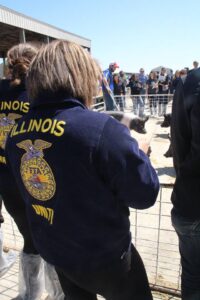Post-graduation agricultural career options

PHOTO SUBMITTED BY FFA Belvidere Daily Republican
FFA members check out the pigs on display in their pen.
Ag Communications, Winnebago-Boone Farm Bureau
We are halfway through the month of May and for anyone in school, that means summer is near. For some of them, that means graduation is near. This year will mark four years since I have graduated high school and a whopping one whole semester since I graduated college. Because it was not very long ago at all, I can resonate well with those who are about to endure this exciting, life changing time. Graduation means new beginnings and the end of an era. But, for those graduating high school, it can bring along a little bit of hesitation. Whether it is college, military, or the work force, there are a lot of decisions to be made. If you are graduating college, there can be some hesitation too. Every transition has its own set of uncertainties.
Most uncertainties stem from the unknown. The main question for most is: what am I going to do with my life? It is a hard decision to make but there is an option that is unfortunately, often overlooked.
Agriculture is the nation’s largest industry, and most important, it employs around 23 million people in over 250 areas. In Illinois specifically, there are close to one million agriculture-related jobs. That makes up 13% of employees in the state. What is interesting is that less than one percent of the nation claims production ag as their occupation. Instead, there are seven main categories that the other areas are broken down into. They include: plant science, animal science, agriculture mechanics, agriculture business, environmental services, food science, and natural resources.
We may only think of farmers as growing crops and animals. When it comes down to it, farmers are required to be diversified in order to keep a farm running. They are required to do many other jobs than just “farmer”. Therefore, because of the many “hats” farmers have to wear, many other job opportunities arise outside of production agriculture.
The trend of choosing to study agriculture in college is rising. In fact, this is seen in many agriculture programs in high schools. In 2013, Byron middle school started offering
For full article, pick up the May 23 BDR.


